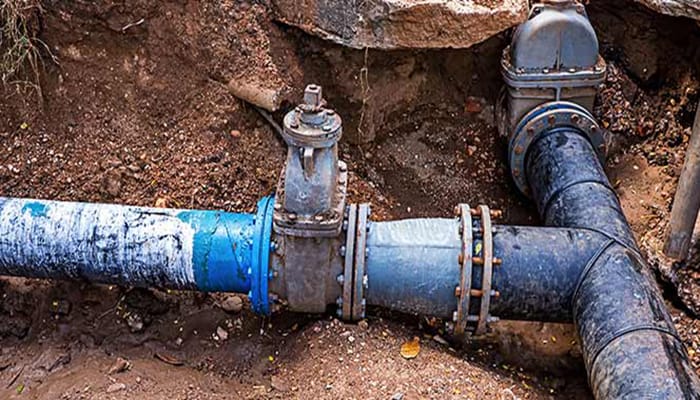
Water lines are critical to your home’s plumbing system, transporting fresh water from the main municipal supply into your house. They also help to increase your comfort and safety.
But, like other plumbing fixtures and fittings, they can get damaged over time. Hence, they must be repaired or replaced regularly to prevent significant damage.
Table of Contents
Clogged Pipes
A clogged pipe is a common problem that can have serious consequences for your plumbing system. There are many reasons why your drain may become clogged, and the solution to this issue is to call in a professional plumber to assess and fix the problem.
When a clog is left untreated, water can eventually back up in the pipe and force it through the piping into your home. This can cause a lot of damage to your sinks, tubs, and showers.
Grease: Oil and grease can be a major cause of clogged pipes. This is because it constricts the pipe size and prevents the water from draining properly. This can be a big problem for your drains, so it’s important to avoid pouring any kind of grease down the drain.
Debris: Other things that can clog your pipes include hair, soap scum, food waste, and dirt. These substances can be difficult to remove and can eventually start to smell.
If you notice a strange smell coming from your drains, it may be time to get them checked out by a professional plumber. This can help to determine the cause of the odor so that you can fix the problem quickly and efficiently.
Old pipes: As the pipes in your house wear down, they will eventually clog up with mineral deposits from hard water. This is especially true for steel pipes, PVC, and copper.
These pipes can also be clogged by tree roots that grow in your yard and end up lining them as they seek out moisture and nutrients.
Leaves: Another reason why sewer lines clog is because they sag. This causes them to bend and makes it easier for debris to collect.
When a sewer line clogs, it can lead to sewage backups into your home, which will require water line repair. This is usually an expensive issue and can be avoided if you take steps to keep your pipes clean and free of obstructions.
There are various ways to keep your plumbing pipes free from clogs and other issues, including putting drain cleaner down your pipes regularly and having professional cleaning done regularly. These tips ensure that your plumbing system is always in good working order.
Frozen Pipes
Frozen pipes are a common winter problem that can cause significant damage to your home and property. They may also lead to costly water line repair and replacement costs. The best way to prevent frozen pipe problems is by proactively protecting your home.
A simple home inspection can reveal which pipes are most at risk of freezing and how to prevent them from bursting. You can do this by knowing where the pipes are located, ensuring that your attic, basement, and crawl space are well insulated, and sealing up any cracks in the exterior walls of your home.
If you live in an area with very cold weather, you may want to consider installing a heater for your attic or basement to prevent pipes from freezing. This is a great way to avoid high repair costs.
Even if you have a heater, you can freeze your pipes in extreme cold. The temperature outside must dip far below freezing to freeze the water inside the pipes.
This is possible because the water inside your pipes expands when it freezes, causing pressure to build up in the pipe. This can then cause the pipe to burst, leaking water into your home and causing serious water damage.
To thaw a frozen pipe, you can use the following methods:
Apply heat to a section of the frozen pipe by wrapping an electronic heating pad or hair dryer around it. This will help the water in the pipe thaw, but keep it on until you have full, normal water pressure.
After the frozen section of the pipe thaws, it is important to check for leaks. If you can see any signs of a leak, it is recommended that you call a professional plumber to thaw the pipe and make repairs.
It is also a good idea to open the faucets connected to your frozen pipe and run the water so that the pressure can be relieved on the non-frozen sections of the pipe. This will allow the pipe to thaw out more quickly and help prevent any additional leaks that could occur later on.
Corrosion
Corrosion, a deterioration caused by chemical or electrochemical reactions, can cause serious issues with your home and plumbing systems. It can lead to leaks, clogged pipes, and rust-colored water. It can even make your water unsafe for consumption.
The rate of corrosion depends on the type of metal and the environment in which it is exposed. Some metals, such as copper, are more resistant to corrosion than others. However, all metals can corrode if exposed to the right conditions.
Rust is one of the most common forms of corrosion that occurs with iron and steel pipes. It can cause pinhole cracks and pipe breakage, resulting in costly repairs or replacements.
Stainless steel, on the other hand, is much slower to corrode. It is also more durable and can last a long time before it needs to be replaced.
Other causes of corrosion include water acidity, poor pipe installation, and microbial growth. These are all important issues to monitor as they can cause serious problems in your plumbing system.
Another common cause of corrosivity is mineral deposits on the inside of the pipes. These minerals can eat away at the copper or lead inside the pipes. If the water is not flushed through the system properly, the deposits can corrode the metal and cause serious issues in your plumbing system.
This is why having your pipes inspected and tested regularly is important. Regular inspections not only help prevent corrosion and extend the life of your pipes, but they can also help save money on repair costs.
It is also important to note that not all corrosive water will affect your piping system. For example, if your water has a low pH, it may not corrode your pipes.
The best way to determine whether your water line is corroding is to have it inspected by a certified plumber. A professional will be able to determine the cause and severity of the problem and recommend a solution to prevent further damage. A professional can also test your water for the presence of contaminants such as copper and lead.
Tree Roots
Tree roots can cause serious problems with your plumbing system, especially if they invade your pipes and block water lines. They’re a natural enemy of plumbing systems, but there are steps you can take to prevent the issue from occurring in the first place.
Roots serve various purposes in the landscape, including anchoring a tree, conducting water and minerals, providing storage for food reserves, and producing organic materials. They also help bind the soil together, suppress weeds, reduce soil erosion, prevent soil compaction and saturation, and improve soil drainage.
Site conditions control the growth and development of a tree’s root system. Many factors influence how well a plant roots, but the three major ones are soil depth, water supply, and aeration.
Healthy roots tend to grow horizontally rather than vertically because they seek the resources closer to the surface of the ground: water, nutrients, and oxygen. When these resources are available, tree roots will expand and flourish.
However, soil compaction, trenching, digging, or filling dirt within a tree’s root zone can damage or inhibit the growth of a tree’s roots. The most common cause of root damage is the loss of pore spaces in soil that hold essential oxygen and water for tree roots.
In addition, fungi can attack large and small feeder roots to reduce the tree’s ability to absorb water and nutrients. These fungi include the species Phytophthora, Pythium, and Fusarium.
Most of these fungi can be treated with chemical herbicides, but some can’t. Fungi that attack large, woody roots are particularly destructive because they disrupt the uptake of water and minerals by tree roots.
They also can destroy cells that transport food to the branches and limbs. This can result in poor growth, decayed cells, and reduced structural support for the tree.
Homeowners can prevent the growth of tree roots in their water and sewer lines by knowing where these lines are, avoiding planting trees near them, applying root inhibitors to the soil around the roots, and regularly inspecting the condition of their sewer line. They can even bury wooden or metal barriers alongside the pipe to keep tree roots from penetrating it.
Follow – https://sggreek.com for More Updates


